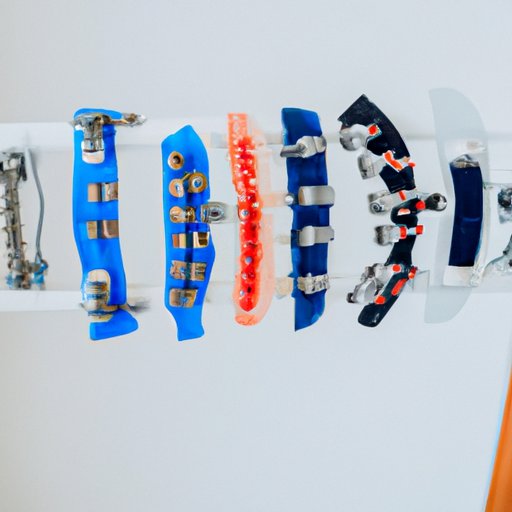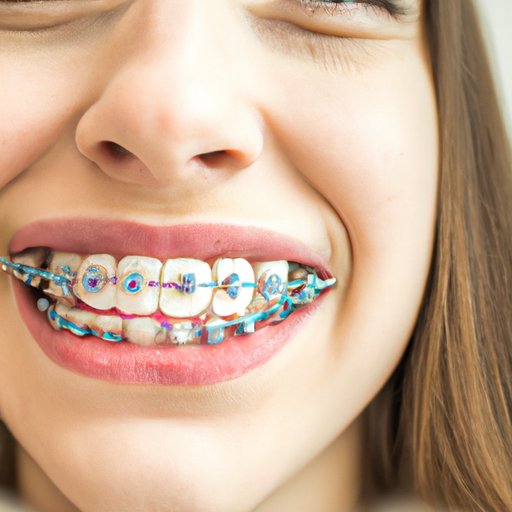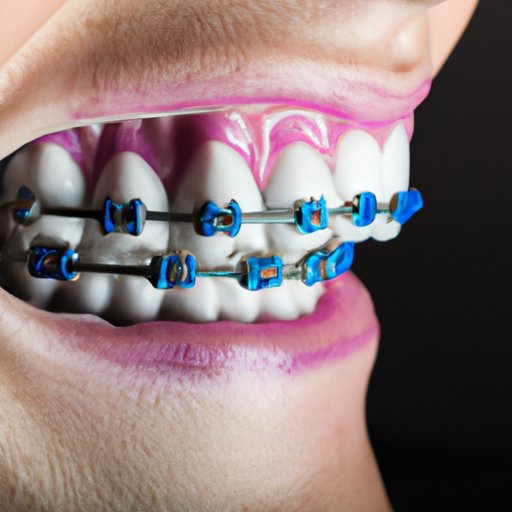Introduction
Braces are a form of orthodontic treatment used to align teeth. The goal of braces is to improve the appearance and health of a person’s smile. Braces are available in different types and sizes, each suited to the individual patient’s needs. They can be used to correct crooked teeth, overbites, underbites, and other issues related to misaligned teeth.

Overview of Different Types of Braces and How They Work
The most commonly used type of braces is metal brackets that attach to the front of each tooth. These brackets are connected by a wire or elastic band, which gradually moves the teeth into their desired positions. In addition to metal braces, there are also ceramic braces, lingual braces, and clear aligners. Ceramic braces are made from clear materials and are less visible than metal braces. Lingual braces are placed on the back side of the teeth and are almost invisible. Clear aligners, such as Invisalign, are custom-made and fit snugly around the teeth. They are removable and replaced with a new set every two weeks.

Benefits and Risks of Wearing Braces
According to a study conducted by the American Association of Orthodontists (AAO), “braces can lead to improved oral health and an improved quality of life”. Orthodontic treatment can help people achieve straighter teeth, a better bite, and a more attractive smile. It can also reduce the risk of gum disease, cavities, and tooth decay. Additionally, braces can help with speech impediments and chewing problems.
However, there are some potential risks associated with wearing braces. The most common complication is discomfort or pain due to the pressure of the braces on the teeth. It is also possible for the braces to cause irritation to the gums and cheeks. There is also a risk of infection if the braces are not kept clean. Finally, there is a risk of permanent damage to teeth and gums if the braces are not adjusted properly.
Cost of Braces and Insurance Coverage
The cost of braces varies depending on the type of braces used and the complexity of the case. According to the AAO, the average cost of braces is between $3,000 and $7,500. Most dental insurance plans cover a portion of the cost of braces. Additionally, many orthodontic offices offer payment plans to make the cost of braces more manageable.

Process of Getting Braces Installed
Before getting braces installed, it is important to consult an orthodontist to determine which type of braces will best suit your needs. During the consultation, the orthodontist will take X-rays and impressions of your teeth to assess the severity of the misalignment. Once the braces have been selected, the orthodontist will prepare the teeth for the braces by cleaning them and filing down any rough spots.
The next step is the installation of the braces. The orthodontist will attach the brackets to each tooth and then connect the brackets with a wire or elastic band. Once the braces are in place, the orthodontist will adjust the tension of the wire or elastic band to ensure the teeth move into the desired positions. The entire process typically takes about one to two hours.
What to Expect During Braces Treatment
After the braces are installed, there is usually an adjustment period of several weeks. During this time, patients may experience soreness and discomfort. Over-the-counter pain medications can be used to alleviate symptoms. Additionally, it is important to maintain good oral hygiene while wearing braces. This includes brushing at least twice a day, flossing daily, and avoiding hard and sticky foods.
It is also important to visit the orthodontist regularly for check-ups and adjustments. During these visits, the orthodontist will tighten the wires or elastic bands to keep the teeth moving in the right direction. The length of treatment varies depending on the severity of the misalignment, but it typically lasts between 18 months and three years.
Traditional vs Clear Braces
Traditional metal braces are the most commonly used type of braces. They are durable, reliable, and relatively inexpensive. However, they are also very visible and can be uncomfortable to wear. Clear braces are less visible and more comfortable, but they are also more expensive and require more maintenance.
When deciding which type of braces to get, it is important to consider the severity of the misalignment. For mild cases of misalignment, clear braces may be the best option. For more severe cases, traditional metal braces may be the only option.
Latest Technologies in Orthodontics
In recent years, there have been significant advances in the field of orthodontics. New technologies, such as 3D printing and laser scanning, are being used to create custom braces that are more comfortable and effective than ever before. Additionally, new treatments, such as Invisalign, are being used to align teeth with minimal discomfort.
These innovations have enabled orthodontists to provide more accurate diagnoses and faster treatments. As a result, people can now achieve straighter teeth and a healthier, more attractive smile in less time than ever before.
Conclusion
Braces are a popular form of orthodontic treatment used to align teeth and improve the appearance and health of a person’s smile. There are many types of braces available, each suited to the individual patient’s needs. While there are potential benefits and risks associated with wearing braces, the cost of braces can be managed with insurance coverage and payment plans. The process of getting braces installed involves an initial consultation, preparation of the teeth, and the installation of the braces. During treatment, patients should practice good oral hygiene and visit the orthodontist regularly for check-ups and adjustments. Finally, there are traditional and clear braces, and the latest technologies in orthodontics are making orthodontic treatments more comfortable and effective than ever before.
(Note: Is this article not meeting your expectations? Do you have knowledge or insights to share? Unlock new opportunities and expand your reach by joining our authors team. Click Registration to join us and share your expertise with our readers.)
